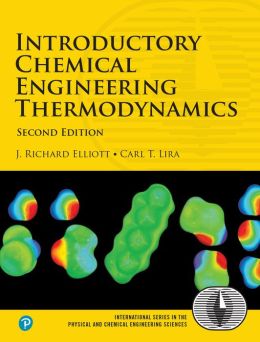This Introductory Chemical Engineering Thermodynamics 2nd Edition eBook is written by J. Richard Elliott, Carl T. Lira for those who are learning the science of chemical thermodynamics. Although this book is just an introduction, but has a discussion of topics relevant to the reader. Since the year 2012 this book is published by Prentice Hall with the total number of pages 912.
You'll get a systematic knowledge because this book is part of the series from Prentice Hall International Series in the Physical and Chemical Engineering Sciences. for sale with a price of about $112.91.
This book as an introduction that can be applied thermodynamics, includes coverage of process simulation model and the introduction of biological systems that are very practical and updated.
This book helps readers to understand the fundamentals of thermodynamics applied as it is practiced today: with an extensive development information from the perspective of a molecule which can allow adaptation to the areas, including environmental, biological systems and nanotechnology applications. This text has the distinction of making molecular point of view way which is accessible at the level of the introductory and associate properties with practical implications.
While many similar books, but this book has the distinction that can be seen with the following features:
- Hierarchical instruction with increasing levels of detail: Content requiring deeper levels of theory is clearly delineated in separate sections and chapters
- Early introduction to the overall perspective of composite systems like distillation columns, reactive processes, and biological systems
- Learning objectives, problem-solving strategies for energy balances and phase equilibria, chapter summaries, and “important equations” for every chapter
- Extensive practical examples, especially coverage of non-ideal mixtures, which include water contamination via hydrocarbons, polymer blending/recycling, oxygenated fuels, hydrogen bonding, osmotic pressure, electrolyte solutions, zwitterions and biological molecules, and other contemporary issues
- Supporting software in formats for both MATLAB® and spreadsheets
- Online supplemental sections and resources including instructor slides, ConcepTests, coursecast videos, and other useful resources
Who is the author of this book? To quote from the page, and following a brief information about the author.
J. Richard Elliott is Professor of Chemical Engineering at the
University of Akron in Ohio. He has taught courses ranging from freshman
tools to senior process design as well as thermodynamics at every
level. He has worked with the NIST lab in Boulder and ChemStations in
Houston. He holds a Ph.D. from Pennsylvania State University.
Carl T. Lira is Associate Professor in the Department of Chemical Engineering and Materials Science at Michigan State University. He teaches thermodynamics at all levels, chemical kinetics, and material and energy balances. He has been recognized with the Amoco Excellence in Teaching Award and multiple presentations of the MSU Withrow Teaching Excellence Award. He holds a Ph.D. from the University of Illinois.
Carl T. Lira is Associate Professor in the Department of Chemical Engineering and Materials Science at Michigan State University. He teaches thermodynamics at all levels, chemical kinetics, and material and energy balances. He has been recognized with the Amoco Excellence in Teaching Award and multiple presentations of the MSU Withrow Teaching Excellence Award. He holds a Ph.D. from the University of Illinois.
Where to buy this Introductory Chemical Engineering Thermodynamics 2nd Edition book?
Book an affordable price makes many people want to have this book soon. And a lot of people who decided to shop online over the internet. Then the book will be delivered to your home or Office. It's so easy.Among the many existing online book stores now, I recommend shopping at Amazon or BN. But I chose Barner & Noble, because in addition to competitive rates, the information provided by the BN is very detail. Click here to get there.








